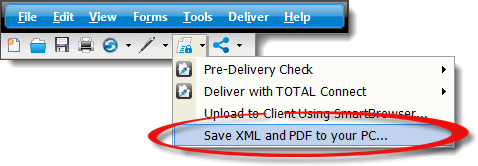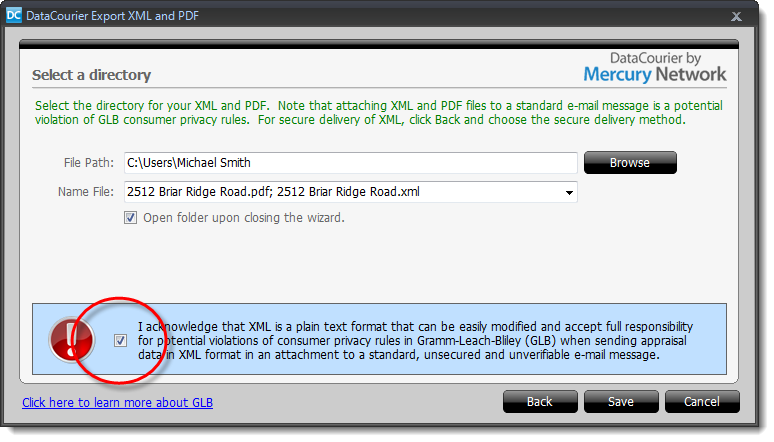DataCourier allows you to save a copy of your XML and PDF file directly to a
location on your computer in order to deliver or store the files based on your
needs.
Attaching MISMO XML and PDF files to a standard email message is a
potential violation of GLB privacy rules, and we definitely DO NOT recommend
it.
To save your MISMO XML and PDF locally:
- Click the drop‑down arrow beside the Deliver to Client
icon (
 ) and select Save XML
and PDF to your PC.
) and select Save XML
and PDF to your PC.

- An E&O check automatically runs, and if any errors are found, you have
a couple of options:
- Yes, correct UAD error. The E&O view shows details
about the errors that were found - UAD and otherwise. Note that you can
double click an error description and jump to the field in the form to
correct it. The Details option shows a more narrative
description of any fields that are in error, and the Client Instructions
option allows you to write notes that are transmitted with the XML and are
viewable by the client.
- Continue. This means you're okay with any errors that
were found and/or have explained why it was necessary to leave these errors
in appraisal. If you're leaving any UAD errors, you can expect to explain
your reasons to your client when they submit the report to UCDP, because
they receive a report of any errors when uploading.
If no UAD errors are found, you're automatically taken to the TOTAL print
engine where you select the pages to be delivered.
- When the TOTAL Print Engine appears, select the pages you want to include
in the PDF copy of the report, then click Continue. This
creates the PDF that is embedded in your MISMO XML file.
- From the Save XML and PDF dialog, a path is automatically
populated for you. To select a different location, click
Browse and browse to any location on you pc or network.
- In the Name File field, file names are assigned based on
a field in the report (the main file number is used by default.)
- Use the drop‑down list to select a different field on which the file
name will be based.
- If you try to save the files using an existing file name, you're
prompted to append a unique number to the new file name, or to overwrite the
existing file.
- Check the box to Open folder upon closing the wizard.
This simply opens the folder where the files are saved, giving you easy
access.
- Before you click Save, you must check the box near the
bottom of the window to acknowledge that you're aware of the risks of sending
appraisal data in XML format using a standard, unsecured email message.

- Click Save, and the files are saved to the location
specified in Step 5.

